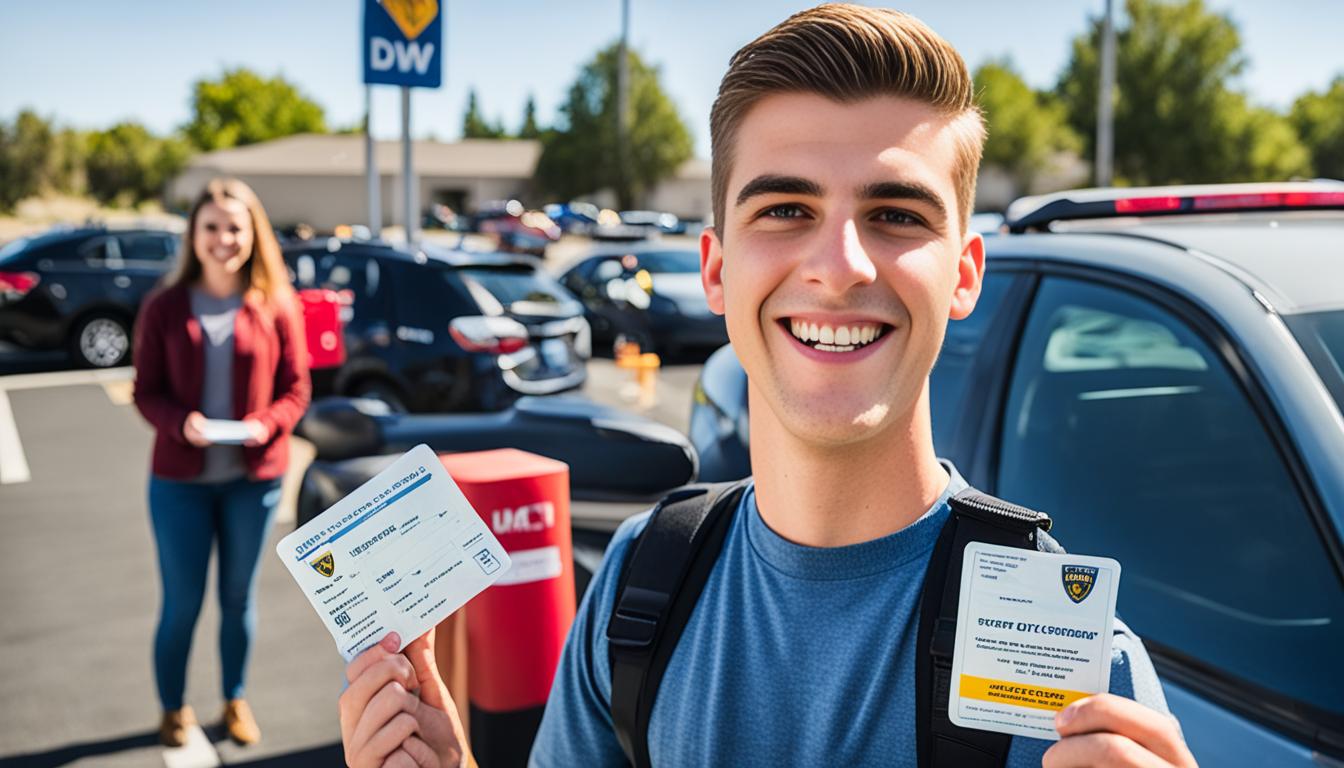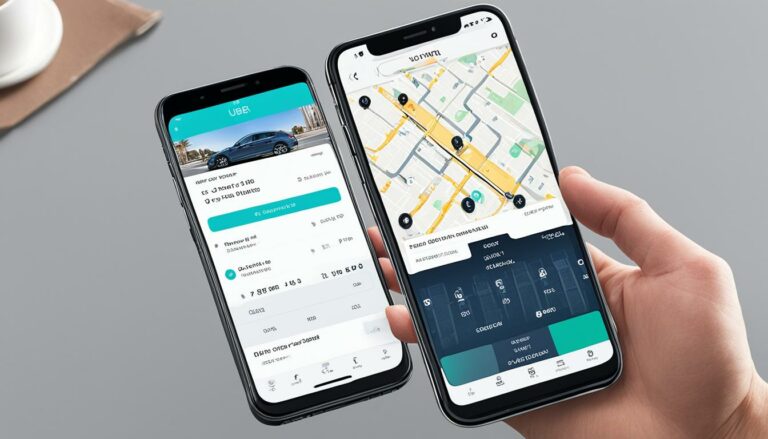Get Your Permit at 16: Quick DMV Guide
Welcome to our quick DMV guide on how to get your permit at 16! If you’re a 16-year-old aspiring driver, you may be eager to start your journey towards obtaining a driver’s license. In this guide, we’ll walk you through the age requirements and application process for getting a permit at 16, as well as the necessary steps to transition to a full license. Let’s dive in!
To obtain a provisional instruction permit at 16, you must be at least 15 1/2 but under 18 years old. You’ll need to complete a Driver License or Identification Card Application (DL 44) form and have your parents or guardians sign it. Make sure to provide an acceptable birth date or legal presence document, as well as a certificate of completion of driver education or enrollment in a driver training program. Don’t forget to pay the required application fee, pass a vision exam, have your photograph taken, give a fingerprint, and pass a knowledge test. Don’t worry, we’ll break down each step in detail throughout this guide.
Are you ready to start the exciting process of getting your permit at 16? Let’s get you on the road to becoming a licensed driver!
Key Takeaways:
- At 16, you can obtain a provisional instruction permit by meeting certain age and application requirements.
- To apply for a permit, complete the DL 44 form, provide necessary documentation, pay the fee, and pass the required tests.
- Completing driver education and training is a crucial step in the process of getting a permit and eventually a driver’s license.
- Once you have your permit, you can start practicing driving with a licensed parent or guardian, a California driver aged 25 or older, or a certified driving instructor.
- Remember to comply with any restrictions placed on your provisional license and always prioritize safe driving habits.
Driver Education Requirements for Getting a Permit at 16

As a 16-year-old aspiring driver, completing a driver education course is a requirement in obtaining your driver’s permit. This course provides essential knowledge and skills necessary for safe and responsible driving. By enrolling in a driver education program, you will gain a comprehensive understanding of road safety, traffic laws, driver responsibilities, and accident avoidance.
The driver education course typically consists of at least 30 hours of approved curriculum. It covers a wide range of topics, including defensive driving techniques, understanding road signs and signals, and navigating challenging driving conditions. The course can be completed through in-person classes or online education programs, allowing you to choose the learning format that suits your preferences and schedule.
When selecting a driver education course, it is crucial to ensure that the program is offered through a licensed school and taught by professional instructors. This ensures the quality and credibility of the curriculum, providing you with the necessary knowledge and skills to become a responsible and confident driver.
Benefits of Completing Driver Education
- Acquiring in-depth knowledge of traffic laws and regulations.
- Gaining a better understanding of road safety principles and accident prevention strategies.
- Developing defensive driving techniques to anticipate and respond to potential hazards.
- Learning how to effectively navigate various driving conditions, such as inclement weather or high-traffic areas.
- Building confidence and competence behind the wheel through practical driving exercises.
Upon successfully completing your driver education course, you will receive a driver education certificate. This certificate serves as proof of your completion and is a requirement when applying for your driver’s permit.
The image above visually represents the importance of driver education for 16-year-olds. It underscores the significance of acquiring the necessary skills and knowledge to navigate the road safely at a young age.
Driver Training for 16-Year-Old Permit Applicants

After completing driver’s education, the next step is driver training. During this phase, you will gain crucial behind-the-wheel experience under the guidance of a professional instructor.
To fulfill the driver training requirements, you must complete a minimum of six hours of supervised driving practice. This practice should be spread out over three separate days, with no more than two hours of training per day. By dedicating this time to honing your driving skills, you will become more confident and prepared for the road ahead.
Choosing a Licensed Driver Training School
It is essential to receive your driver training from a reputable and licensed school, approved by the California DMV. By entrusting your education to a licensed school, you can have peace of mind knowing that you are receiving quality instruction.
To verify a school’s credibility, you can check the DMV’s school license status information database. This database will provide information on whether the school is licensed and bonded, ensuring that you are making a reliable choice for your driver training.
Remember, driver training is an integral part of building your skills and knowledge as a young driver. By completing the required hours of practice with a licensed instructor, you will develop important habits and techniques that will contribute to your overall safety on the road.
Instruction Permit Application Process at 16
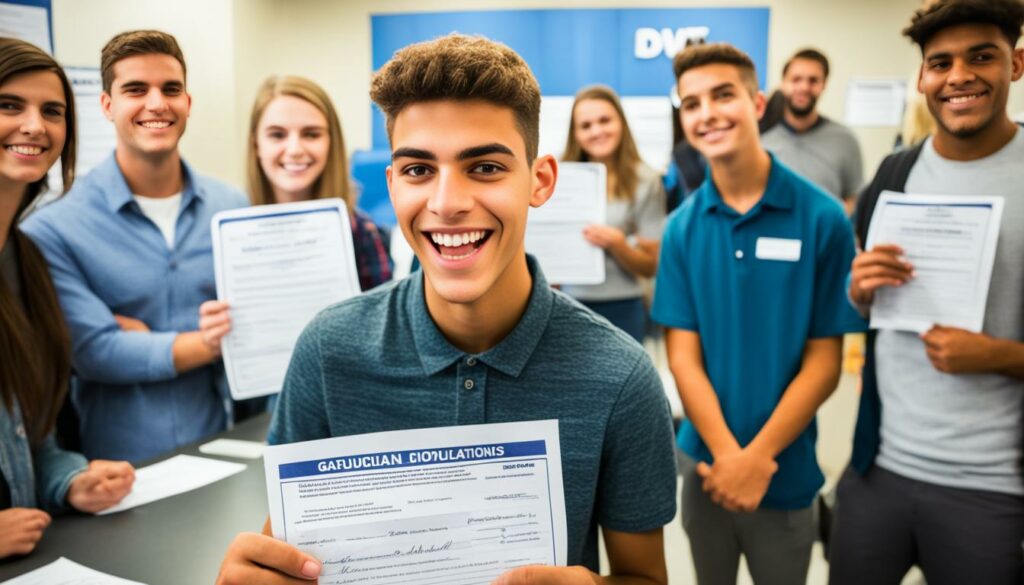
Once you have completed driver education and enrolled in a driver training program, you are ready to take the next step and apply for an instruction permit at the DMV. This permit will allow you to gain valuable driving experience under the supervision of a licensed adult. Here’s what you need to know about the application process:
- Complete the Application Form: Start by filling out the instruction permit application form. You can obtain this form from your local DMV office or download it online. Fill in all the required information accurately and double-check for any errors.
- Pay the Application Fee: Along with the completed form, you will need to submit the non-refundable instruction permit application fee. The fee amount may vary, so it’s best to check with your local DMV office for the exact cost. Be prepared to make the payment in the form of cash, check, or debit/credit card.
- Provide Documentation: In addition to the application form and fee, you will need to provide specific documents to prove your eligibility for an instruction permit. These may include a proof of completion of driver education, a birth date/legal presence document, and identification documents. Ensure that you have all the necessary documentation before visiting the DMV.
- Pass the Vision Test: During the application process, you will be required to undergo a vision test to assess your visual acuity. The test is simple and involves reading a chart of letters or numbers. If you require corrective lenses, make sure to wear them during the test.
- Have Your Photograph Taken: After passing the vision test, you will have your photograph taken for your permit. Smile and present yourself confidently, as this photo will appear on your instruction permit.
Important Reminder:
Keep in mind that with an instruction permit, you can only drive when accompanied by a licensed parent or guardian, a California driver aged 25 or older, or a certified driving instructor. This supervised driving experience is crucial for gaining practical skills and building confidence on the road. Always follow the provisions and restrictions of your instruction permit to ensure a safe and successful learning journey.
Now that you are familiar with the instruction permit application process, you are one step closer to becoming a licensed driver. Remember that practice and guidance are key to developing safe driving habits. Keep your goals in sight and continue to learn and improve as you prepare for the next stages of obtaining your driver’s license.
Image: Applying for an instruction permit at 16 is an exciting step towards becoming a licensed driver.
The Process of Getting a Driver’s License at 16
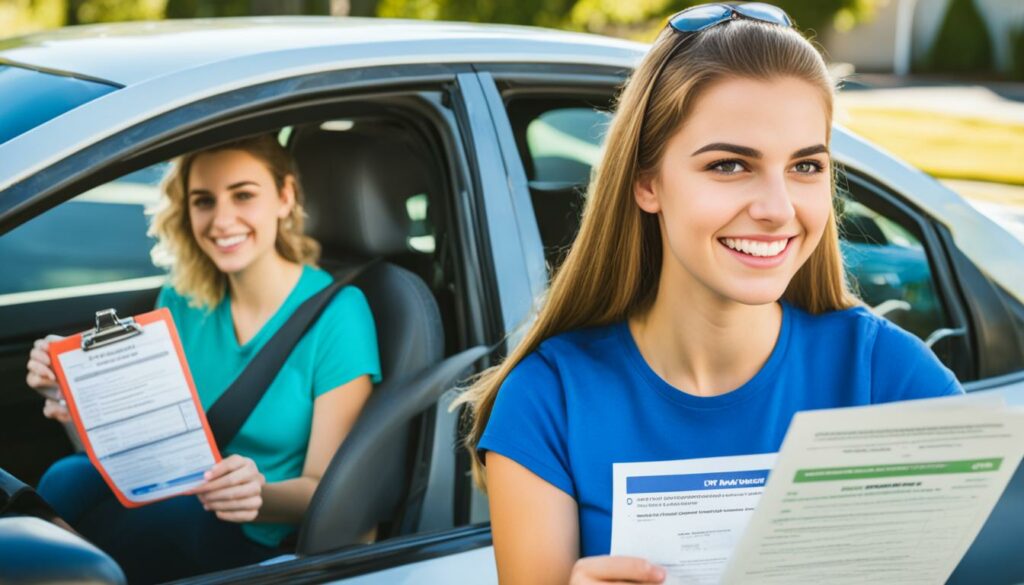
When you turn 16 and meet the requirements for a driver’s license, you can apply for one. To apply, you must have completed driver education and training, and have an instruction permit that verifies you have completed at least 50 hours of supervised driving practice, including 10 hours of night driving.
The California DMV provides a parent-teen driver training guide that will assist you in the application process. Once you are prepared, schedule an appointment at the DMV to take your required driver knowledge and in-car driving tests.
| Requirements for Getting a Driver’s License at 16 |
|---|
| Completed driver education and training |
| Instruction permit with at least 50 hours of supervised driving practice, including 10 hours of night driving |
| Appointment at the DMV |
| Passing the driver knowledge and in-car driving tests |
Preparing for the Driver Knowledge and In-Car Driving Tests
Before you take the driver knowledge and in-car driving tests, it’s essential to prepare adequately. The driver knowledge test assesses your understanding of traffic laws, road signs, and safe driving practices, while the in-car driving test evaluates your ability to handle a vehicle and follow instructions.
- Study the California Driver Handbook: Review the handbook thoroughly to familiarize yourself with the rules of the road.
- Take practice tests: Online practice tests can help you get comfortable with the format and content of the driver knowledge test.
- Practice your driving skills: Spend additional time practicing different driving maneuvers, such as parallel parking, lane changes, and turns.
- Review the DMV’s driving test checklist: The checklist outlines the skills and knowledge you need to demonstrate during the in-car driving test.
With proper preparation and practice, you can increase your chances of passing both tests and obtaining your driver’s license at 16.
Passing the Driver Knowledge and In-Car Driving Tests

Obtaining your provisional driver’s license requires successfully passing the driver knowledge and in-car driving tests. These assessments evaluate your understanding of traffic laws and your ability to safely operate a vehicle.
To ensure a successful outcome, it is essential to adequately prepare for these tests. The California DMV provides various resources and training options to aid in your preparation:
- Driver Training and Education Courses: The DMV offers driver training and education courses designed to equip you with the necessary knowledge and skills to pass the tests. These courses cover essential topics such as traffic laws, road signs, and safe driving practices.
- Parent-Teen Training Guide: The DMV provides a comprehensive guide that outlines the step-by-step process of obtaining a driver’s license. This guide offers valuable tips, practice exercises, and suggestions for practicing driving skills with your parent or guardian.
When attempting the tests, keep in mind the following:
- Driver Knowledge Test: The knowledge test assesses your understanding of traffic laws, road signs, and safe driving practices. You will have three attempts to pass this test. If you fail, you must pay a retest fee and try again.
- In-Car Driving Test: The in-car driving test evaluates your practical driving skills. It assesses your ability to navigate different traffic situations, use proper signaling, perform maneuvers, and adhere to traffic laws. Like the knowledge test, you have three attempts to pass this test.
By taking advantage of the available resources, adequately preparing, and practicing your driving skills, you can increase your chances of passing the driver knowledge and in-car driving tests and obtaining your driver’s license.
| Test | Number of Attempts | Retest Fee |
|---|---|---|
| Driver Knowledge Test | 3 | $35 |
| In-Car Driving Test | 3 | $35 |
Restrictions for 16-Year-Old Provisional License Holders
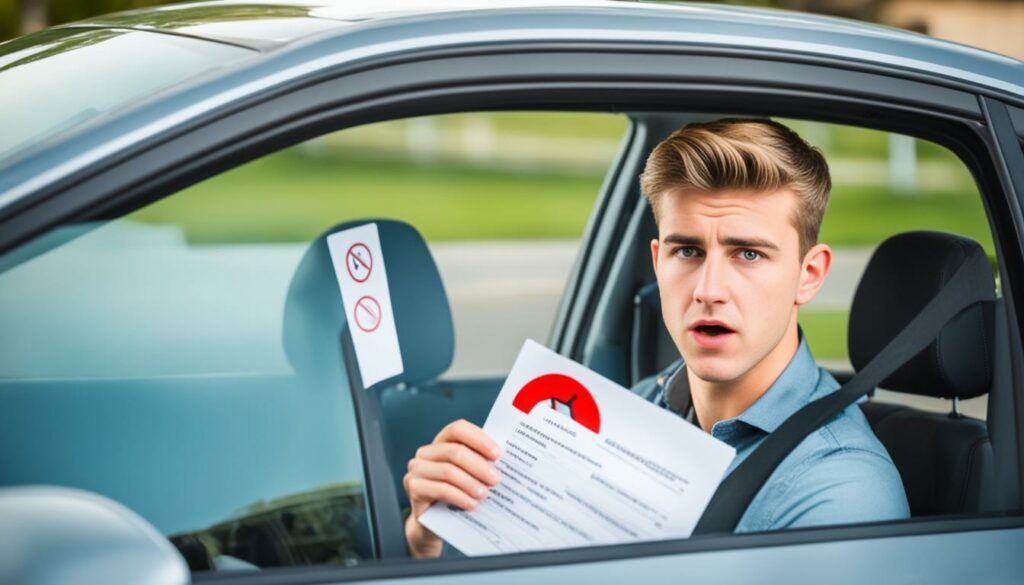
As a 16-year-old with a provisional driver’s license, it’s important to be aware of the restrictions that apply to you. These restrictions are in place to ensure your safety and the safety of others on the road.
Driving Curfew
Between 11:00 p.m. and 5:00 a.m., you are not allowed to drive unless you are accompanied by a licensed parent or guardian, a California driver aged 25 or older, or a certified driving instructor. This driving curfew helps reduce the risk of accidents during nighttime hours when visibility is reduced.
Passenger Restrictions
When driving with a provisional license, you are not permitted to have passengers under the age of 20 in the car, unless accompanied by a licensed adult who is at least 25 years old. This restriction is in place to minimize distractions and promote focused driving.
Cellphone Use
Using a cellphone or any other wireless electronic communication device while driving is against the law for drivers under the age of 18, unless it’s for making a call to emergency services. It’s important to avoid distractions and keep your attention on the road to ensure everyone’s safety.
| Restrictions | Provisional License Holders |
|---|---|
| Driving Curfew | 11:00 p.m. – 5:00 a.m. |
| Passenger Restrictions | No passengers under the age of 20, unless accompanied by a licensed adult |
| Cellphone Use | Only for emergency calls |
Adhering to these restrictions is crucial for young drivers to gain experience and develop good driving habits. By following these rules, you can ensure your safety and the safety of others on the road.
Transitioning to a Full License at 18
When you turn 18, it’s an exciting milestone as your provisional license restrictions are lifted and you become a fully licensed California driver. At this point, you will no longer have any driving restrictions, granting you the freedom to drive anywhere and at any time.
If desired, you can visit the DMV and obtain a duplicate driver’s license without the word “provisional” on it. This can serve as a symbolic transition from a provisional license to an unrestricted driver’s license, marking your entry into adulthood and independence on the road.
However, it’s important to note that your driver’s license will still have an expiration date. To ensure that you can continue driving legally, you will need to renew your driver’s license before it expires. It’s crucial to stay on top of the renewal process and be aware of the expiration date to avoid any future difficulties.
Key Takeaways
Turning 18 signifies the transition to a full, unrestricted driver’s license.
You can obtain a duplicate driver’s license without the word “provisional” on it.
Your driver’s license will still have an expiration date, so it’s important to renew it when necessary.
| Age | Stage | Driving Permit | Driver’s License |
|---|---|---|---|
| 16 | Provisional License | Yes | No |
| 18 | Full License | No | Yes |
Note: The table above summarizes the different stages of obtaining a driving permit and driver’s license.
Safe Driving Tips for Teen Drivers
As a new teen driver, it’s important to prioritize safety on the road. By following these safe driving tips, you can reduce the risk of accidents and ensure the well-being of yourself and others.
1. Always Wear Your Seatbelt
Seatbelts save lives. Make it a habit to buckle up before starting your vehicle. Ensure that all passengers are also wearing their seatbelts.
2. Obey Traffic Laws
Respect traffic laws and regulations. Adhere to speed limits, stop signs, and traffic signals. Avoid aggressive driving behaviors such as tailgating and excessive speeding.
3. Avoid Distractions Like Cellphones
Keep your focus on the road and avoid distractions, especially cellphones. Texting, calling, or using social media while driving can significantly impair your ability to react to potential hazards.
4. Be Mindful of Other Road Users
Stay vigilant and aware of other road users, including pedestrians, cyclists, and motorcyclists. Yield to pedestrians at crosswalks and maintain a safe distance when sharing the road with cyclists or motorcyclists.
5. Practice Defensive Driving
Adopt defensive driving techniques to anticipate and respond to potential hazards. Maintain a safe following distance, use your mirrors frequently, and check blind spots before changing lanes.
Teen Driving Statistics
The importance of safe driving for teens cannot be overstated. Here are some concerning statistics that highlight the need for proactive measures:
| Statistic | Value |
|---|---|
| Leading cause of death for teens | Car accidents |
| Teen driver involvement in fatal crashes | One in five |
| Percentage of teen driver fatal crashes involving distracted driving | 10% |
| Percentage of teen passenger deaths in cars driven by other teenagers | 57% |
Source: National Highway Traffic Safety Administration (NHTSA)
“Safe driving is not only a responsibility but also a commitment to protecting lives. As a teen driver, you have the power to make a difference on the road by practicing safe driving habits and being mindful of others.”
Remember, safe driving is a lifelong skill. By adopting these safe driving tips and following the rules of the road, you are setting yourself up for a lifetime of responsible and defensive driving.
Conclusion
Obtaining a permit and then a driver’s license at 16 is a momentous achievement. By following the steps outlined in this guide, you can successfully navigate the DMV requirements and begin your journey as a responsible driver. Remember to complete driver education and training, pass the required tests, and adhere to any restrictions placed on your provisional license.
Becoming a responsible and safe driver is crucial not just for yourself but also for other road users. It sets the foundation for a lifetime of good driving habits. Always wear your seatbelt, obey traffic laws, and maintain a safe following distance. Avoid distractions like cellphones and be vigilant of pedestrians and cyclists.
As you transition into a fully licensed driver at 18, the restrictions on your provisional license will be lifted. Enjoy the freedom that comes with it, but remember to continue practicing safe driving habits. Keep in mind that your driver’s license will have an expiration date, so be sure to renew it when necessary.
FAQ
What is the age requirement to get a permit at 16?
To obtain a provisional instruction permit at 16 years old, you must be at least 15 1/2 but under 18 years old.
What are the requirements for getting a permit at 16?
To get a permit at 16, you need to complete a Driver License or Identification Card Application (DL 44) form, have your parents or guardians sign it, provide acceptable birth date/legal presence or identity documents, present a certificate of completion of driver education or enrollment in a driver training program, pay the application fee, pass a vision exam, get your photograph taken, give a fingerprint, and pass a knowledge test.
What are the driver education requirements for getting a permit at 16?
As a 16-year-old, you are required to complete a driver education course, which includes at least 30 hours of approved curriculum covering road safety, traffic laws, driver responsibilities, and accident avoidance. You can choose between in-person classes or online education programs taught by a professional instructor from a licensed school.
What is the process for driver training at 16?
After completing driver education, you need to complete at least six hours of behind-the-wheel training with a licensed school and instructor approved by the California DMV. The training should take place on three separate days, with a maximum of two hours of training per day. Make sure to check the DMV’s school license status information database to verify the school’s licensing and bonding status.
How do I apply for an instruction permit at 16?
To apply for an instruction permit at 16, you need to complete an application form, pay a non-refundable application fee, have your fingerprints scanned, provide proof of completion of driver education, pass a vision test, and have your photograph taken. Remember that you can only drive with an instruction permit when accompanied by a licensed parent or guardian, a California driver aged 25 or older, or a certified driving instructor.
What is the process of getting a driver’s license at 16?
To get a driver’s license at 16, you must have completed driver education and training, and have an instruction permit that verifies you have completed at least 50 hours of supervised driving practice, including 10 hours of night driving. Schedule an appointment at the DMV to take your required driver knowledge and in-car driving tests.
What do I need to know about passing the driver knowledge and in-car driving tests?
To obtain your provisional driver’s license, you must pass California’s driver knowledge and in-car driving tests. These tests assess your understanding of traffic laws and your ability to safely operate a vehicle. The DMV provides driver training and education courses, as well as a parent-teen training guide, to help you prepare for these tests.
What are the restrictions for 16-year-old provisional license holders?
As a 16-year-old with a provisional driver’s license, you cannot drive between 11:00 p.m. and 5:00 a.m. unless accompanied by a licensed parent or guardian, a California driver aged 25 or older, or a certified driving instructor. You also cannot have passengers under the age of 20 in the car, unless accompanied by a licensed adult. Additionally, it is against the law for drivers under 18 years old to use a cellphone or other wireless electronic communication device while driving, unless making a call for emergency services.
What happens when I turn 18 with a provisional license?
When you turn 18, your provisional license restrictions are lifted, and you become a fully licensed California driver. At this point, you no longer have any driving restrictions. If desired, you can visit the DMV and obtain a duplicate driver’s license without the word “provisional” on it.
What are some safe driving tips for teen drivers?
As a new teen driver, it’s important to practice safe driving habits. Always wear your seatbelt, obey traffic laws, avoid distractions like cellphones, and be mindful of other road users, especially pedestrians and cyclists. Defensive driving techniques, such as maintaining a safe following distance and anticipating potential hazards, can help you stay safe on the road.
Source Links
- https://www.idrivesafely.com/defensive-driving/trending/everything-you-need-know-about-getting-your-california-drivers-license-teen
- https://www.dmv.ca.gov/portal/driver-education-and-safety/educational-materials/fast-facts/provisional-licensing-ffdl-19/
- https://www.dmv.ca.gov/portal/driver-education-and-safety/special-interest-driver-guides/teen-drivers/

